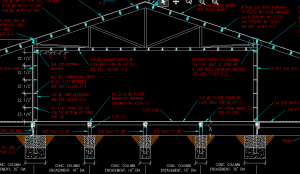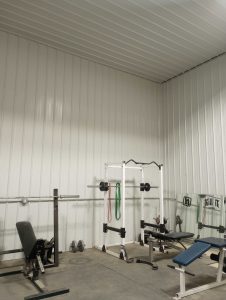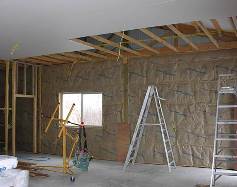Easier to Ask Permission, Than Beg for Forgiveness
Our actual client writes:
“I need you to please help me. I need a letter from engineering that states that the ceiling can withstand tongue and groove plywood being hung on it. We decided to keep part of the ceiling vaulted and open and are going to do blue pine tongue and groove wood there. The county is fine with it. As long as they have a letter from engineering that stated the ceiling will be ok with it (insulating with spray insulation under the tongue and groove).”
Had client expressed this desire initially, it could easily (and likely less costly than what they did order) have been engineered.
Here is my response:
 Your building is designed, as ordered by you, with ceiling loaded trusses, designed for a 10 psf (pounds per square foot) dead load, including ceiling joists 24″ on center. This is reflected in your engineer sealed structural building plans.
Your building is designed, as ordered by you, with ceiling loaded trusses, designed for a 10 psf (pounds per square foot) dead load, including ceiling joists 24″ on center. This is reflected in your engineer sealed structural building plans.
This provides for load carrying capabilities and appropriate framing across your roof truss bottom chords.
Your building’s roof truss top chords (and subsequently purlins between) are designed for a 3.3 psf dead load. This is adequate only to carry weight imposed by roof steel, roof purlins and truss itself.
Loads not used on one chord, cannot simply be transferred to another chord. From experience of designing trusses for nearly five decades, I can attest to this.
In order to have a finished ceiling, supported by roof purlins (with slope of roof), a truss repair would be required to support this additional top chord load. Repairs would be detailed by engineer who sealed your roof truss designs. This could result in one or more of several outcomes – including (but not limited to) plywood gussets being added to some or all truss faces where steel connector plates are currently placed, “scabs” (dimensional lumber) being added to face(s) of truss members, or even another truss being added to what currently exists.
Beyond this, deflection criteria dictate roof purlins must be “stiffer” when supporting materials other than just roof steel. This is typically solved by adding another purlin half-way between each existing roof purlin.
Without ceiling joists installed between truss bottom chords, additional bracing will be required in order to properly brace trusses.
Some of these alterations may prove difficult to achieve in an ‘as built’ situation.
This story has a moral – similar to measure twice, cut once….think it through twice in advance, build it right once.
 The common reasoning in using liner panels, as opposed to say… gypsum wallboard, is they are far lighter in weight, so the roof trusses do not need to carry as high of a load. Many people seem to feel the use of white painted liner panels, contributes to the building being brighter inside, when lights are turned on. Cost is also often mentioned as a factor, however properly installed liner panels, with framing close enough to minimize sagging, and drywalled systems are fairly close to the same price.
The common reasoning in using liner panels, as opposed to say… gypsum wallboard, is they are far lighter in weight, so the roof trusses do not need to carry as high of a load. Many people seem to feel the use of white painted liner panels, contributes to the building being brighter inside, when lights are turned on. Cost is also often mentioned as a factor, however properly installed liner panels, with framing close enough to minimize sagging, and drywalled systems are fairly close to the same price. But – isn’t a ceiling fairly light? It will depend upon what the ceiling is going to be constructed of.
But – isn’t a ceiling fairly light? It will depend upon what the ceiling is going to be constructed of.





